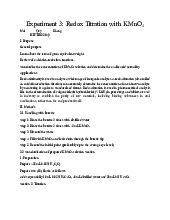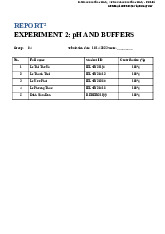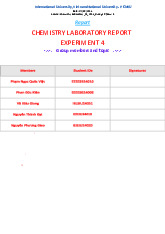





Preview text:
Prelab experiment 2 Mai Quý Khang BTFTIU22049 I/ Purpose General purpose:
Distingiush between strong and weak acids.
Learn how to calculate and prepare a buffer solution and test its buffering ability. Applications:
Calculating the pH of water can test the purity of water and does not have impurities.
Environmental water is also evaluated with pH testing equipment to monitor environmental changes. II/ Methods 2.1 Deionized water
Measure 50mL deionized water in the cylinder and then pour into the beaker, take the stirring rod
and stir for 20 seconds then stop and record pH, continuously stir in 20 seconds then stop and
record pH, continuously stir in 20 seconds then stop and record pH. Keep doing the same
procedure until there is no significant change in pH value. 2.2 Strong acid Section 1: Preparation
Using the cylinder to measure 10mL 0.1M HCl into beaker #1 and 20mL 0.1M NaOH into beaker #2
Prepare 100 mL 0.01M NaOH solution: using the pipette to take 10mL 0.1M NaOH and put it
into the volumetric flask. Then use the cylinder measure 90mL H O 2 and add to the volumetric
flask. Close the cap and shake the flask gently. Section 2: pH measurement
Step 1: Use the pipette take 10mL 0.1M HCl and add to the beaker then record pH.
Step 2: Measure 90 mL distilled water add to beaker then record pH.
Step 3: Use the pipette take 10 mL 0.1M NaOH and add to the beaker then record pH.
Step 4: Finally, measure 90mL 0.01M NaOH and add to the beaker then record pH. 2.3 Weak acid Section 1: Preparation
- Solution A: Measure 20mL 0.1M CH COOH by the cylinder 3 .
- Solution B: Use the pipette take 10mL 0.1M CH COOH 3
and put it into the volumetric flask.
Then use the cylinder measure 90mL H2O and add to the voumetric flask. Close the cap and shake the flask gently.
- Solution C: Use the pipette take 10mL 0.01M CH3COOH and put it into the volumetric flask.
Then use the cylinder measure 90mL H2O and add to the voumetric flask. Close the cap and shake the flask gently. Section 2: pH measurement
Beaker #1: Use the cylinder measure 20mL solution A and put it into the beaker then record pH, Ka.
Beaker #2: Use the cylinder measure 20mL solution B and put it into the beaker then record pH, Ka.
Beaker #3: Use the cylinder measure 20mL solution C and put it into the beaker then record pH, Ka. 2.4 Salts Section 1: Preparation
- Solution A: Use the cylinder measure 20mL 0.1M NaCl and put it into the beaker #1.
- Solution B: Use the cylinder measure 20mL 0.1M CH COONa and put it into the beaker #2. 3
- Solution C: Use the cylinder measure 20mL 0.1M NH Cl and put it into the beaker #3. 4 Section 2: pH measurement
Beaker #1: record pH, Ka of solution A.
Beaker #2: record pH, Ka of solution B.
Beaker #3: record pH, Ka of solution C. 2.5 Buffers Section 1: Preparation
Beaker #1: Use the cylinder measure 50mL CH3COOH and put it into the beaker.
Beaker #2: Use the cylinder measure 50mL CH3COONa and put it into the beaker.
Beaker #3: Use the cylinder measure 40mL HCl and put it into the beaker.
Beaker #4: Use the cylinder measure 40mL NaOH and put it into the beaker. Section 2: Buffer A
Use the cylinder measure 10mL 0.1M CH COOH and 40mL 3 0.1M CH COONa then pour both 3 of
solutions into beaker A. Then record the pH 2 times.
Use the cylinder measure 25mL solution A and put it into beaker A2. Then record the pH both of the beaker A1 and A2.
Beaker A1: Use the pasteur pipette to add 10 drops 0.1M HCl into the beaker then record the pH.
Continuously add more drops 0.1M HCl until the pH changes by one unit from the start, record VHCl (in drops).
Beaker A2: Use the pasteur pipette to add 10 drops 0.1M NaOH into the beaker then record the
pH. Continuously add more drops 0.1M NaOH until the pH changes by one unit from the start, record VNaOH (in drops). Section 3: Buffer B
Use the cylinder measure 40mL 0.1M CH COOH and 10mL 3 0.1M CH COONa then pour both 3 of
solutions into beaker A. Then record the pH 2 times.
Use the cylinder measure 25mL solution B and put it into beaker B2. Then record the pH both of the beaker B1 and B2.
Beaker B1: Use the pasteur pipette to add 10 drops 0.1M HCl into the beaker then record the pH.
Continuously add more drops 0.1M HCl until the pH changes by one unit from the start, record VHCl (in drops).
Beaker B2: Use the pasteur pipette to add 10 drops 0.1M NaOH into the beaker then record the
pH. Continuously add more drops 0.1M NaOH until the pH changes by one unit from the start, record VNaOH (in drops). III/ Safety precautions
Natri hydroxide (NaOH) is a dangerous chemical, it will corrode and cause skin blisters. It might
causes allergies, burns or maybe blindness. Causes allergies, burns or scars when exposed to skin.
Acid hydrochloric (HCl) is also highly corrosive when in contact with the body. Breathing in
fumes causes coughing, choking, and inflammation of the nose, throat, and upper respiratory system.
Therefore, when using natri hydroxide (NaOH) or acid hydrochloric (HCl), we need to strictly
follow the regulations on dosage and process. Prepare protective equipment and tools for contact. IV/ Suggested questions
1. What is the dissociation process? Write down the disscociation constant for CH3COOH + H O 2 ⇌ CH COO- + 3 + H3O ?
The dissociation constant is defined as the ratio of dissociated ions to the original acid or bases in the solution.
2. What are the concentrations of hydronium ions ([H -
3O+]) and hydroxyl ions ([OH ]) of pure water?
The concentration of H₃ O ⁺ (hydronium ion) and OH⁻ (hydroxide ion) in pure water is 10⁻⁷ .
3. What is the product of the concentration of hydronium ions ([H - 3O+]) and hydroxyl ions (OH ) aqueous solution?
The product of [H3O+] = [OH-] is the ionic product of water.
4. What is pH? How do we define/calculate the pH value of a solution?
pH is a measure of how acidic or basic water is. The range goes from 0-14, with 7 being neutral.
pHs of less than 7 indicate acidity, whereas a pH of greater than 7 indicates a base.
The pH scale is a compact way to specify the acidity of a solution: pH = - log[H3O+].
5. If [H3O+] = 0.001M. What is the pH value? 0.001M = 10-3M => pH = - log[10-3] => pH = 3
6. What equipment can you use to measure the pH of prepared solutions?
You can use the purple litmus paper to measure the pH.
7. Please give the definitions of an acid and a base according to Arrhenius classification?
According to the Arrhenius theory, an acid is a substance that dissociates in water to form
hydronium ion (H3O+), and a base is a substance that dissociates in water to form hydroxide (OH-) ions.
8. What is the conjugate base of CH3COOH?
CH3COOH is a weak acid and in equilibrium with its ions in water and its conjugate (CH COO–, 3
a weak base) is also in equilibrium in water.
9. What is a buffer? What is its main characteristic?
Buffer is a solution whose pH is not altered to any great extent by the addition of small quantities
of either an acid or base is called buffer solution.
Characteristics of buffer solution - It has a definite pH.
- Its pH does not change on standing for long periods of time.
- Its pH does not change on dilution.
- Its pH is slightly changed by the addition of small quantity of an acid or base.
11. If the original pH of buffer A is 4, if we add enough HCl to change pH by one unit, what is the final pH value? If we add enough HCl to change pH by one unit, the final pH value of buffer A is pH= 4-1=3 If we add enough HCl to change pH by one unit, the final pH value of buffer A is pH= 4-1=3 If we add enough HCl to change pH by one unit, the final pH value of buffer A is pH= 4-1=3
If we add enough HCl to change pH by one unit, the final pH value of buffer A is pH = 3.
12. If the original pH of buffer A is 4, if we add enough NaOH to change pH by one unit, what is the final pH value?
If we add enough NaOH to change pH by one unit, the final pH value of buffer A is pH = 5.




